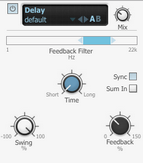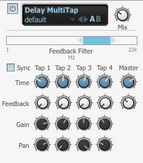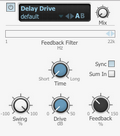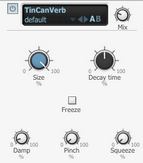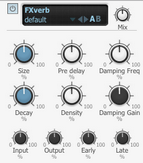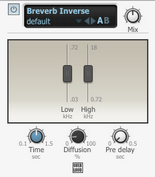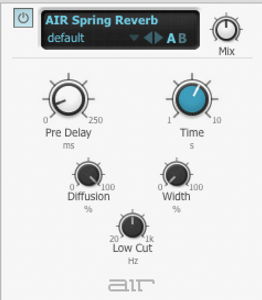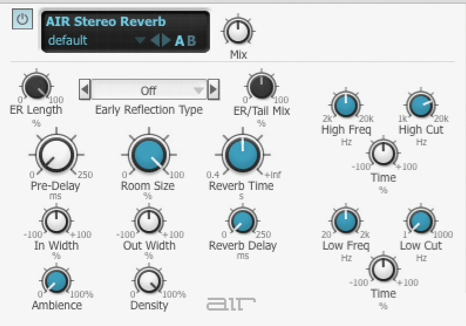Delay
|
The Delay effect can operate as a stereo or mono delay line, depending on whether it is used on a stereo or mono channel. Time The delay Time can be set either in absolute time values in seconds or in tempo-based values (selectable using the Sync control). Sync When the Sync button is set to BPM, the delay time is set in tempo-based values relative to BFD3's current tempo. Possible values range from 64th note to 2 bars, including dotted and triplet variations, the latter being especially useful for classic shuffle grooves using simple ¼-note input. In Seconds mode, the delay time is set as an absolute time value, ranging from 31 ms to 4 seconds. |
Feedback
The Feedback control sets the amount of delay regenerations, caused by feeding the delayed signal back into the input. Higher values feed the delayed signal back in at a higher amplitude, leading to more regenerations of the input signal. Settings of 100% lead to indefinite regenerations until the value is reduced, and with good use of the built-in filtering can result in classic psychedelic, dubby analog delay effects.
Swing
The delay features 2 taps, which are played at the same time with the swing control at the centre position.
By turning down the Swing control, you can move the left tap before the right tap, up to a distance of half the delay time. By turning up the Swing control, the right tap is moved up to a distance of half the delay time before the left tap.
This control opens up a wide variety of swung delay grooves.
Feedback Filter
This control consists of a high-pass and low-pass filter allowing you to apply tonal shaping to each delay regeneration.
To adjust this control, click and drag the light blue arrows at the left and right of the blue active frequency band - the light-blue arrows represent the cutoff frequencies of the high-pass and low-pass filters.
Sum In (stereo only)
When the Delay is used on a stereo channel, activating this button sums the left and right inputs to a single mono signal and feeds one delay line instead of two.
Delay Multi Tap
|
This device provides 4 separate delay taps. Time The 4 Time controls set the delay time for each of the 4 delay taps. Sync When the Sync parameter is set to BPM, the delay time is set in tempo-based values relative to BFD3's current tempo. Possible values range from 64th note to 2 bars, including dotted and triplet variations, the latter being especially useful for classic shuffle grooves using simple ¼-note input. In Seconds mode, the delay time is set as an absolute time value, ranging from 31ms to 4 seconds. Gain The 4 Gain controls allow you to set the level of each of the 4 delay taps. |
Feedback
The 4 Feed controls set the amount of feedback for each of the 4 delay taps.
Pan (Stereo only)
When the device is used on a stereo channel, the Pan control allows each of the 4 taps can be positioned within the stereo field.
Feedback Filter
This control consists of a high-pass and low-pass filter allowing you to apply tonal shaping to each delay regeneration - the same filtering settings are applied to all 4 delay taps.
To adjust this control, click and drag the light blue arrows at the left and right of the blue active frequency band - the light-blue arrows represent the cutoff frequencies of the high-pass and low-pass filters.
Time (Master)
This control offers a master control for the delay time of all 4 delay taps. It applies an offset to the Time settings for all 4 taps.
Feedback (Master)
This control offers a master control for the feedback of all 4 delay taps. It applies an offset to the Feedback settings for all 4 taps.
Delay Drive
|
This device is a version of the Delay with an additional circuit-modelled overdrive stage. The Drive parameter adjusts the amount of overdrive. |
TinCanVerb
|
This effect is a recreation of a cheap-sounding room reverb unit, perfect for trashy sounding drum mixes and an antidote to the lush, real ambience in BFD3's recordings. It is not intended to serve the function of a premium quality digital reverb – for this purpose, it's best to use a good quality external reverb plugin or hardware unit. Size The Size control lets you adjust the size of the virtual reverberation room. Smaller rooms offer subtle ambience, while large rooms result in a more 'cavernous' and reflective effect. Decay time This control adjusts the Decay time of the reverb effect. Use shorter settings for subtle small room effects and longer times for special effects. |
Damp
Increasing the Damp control results in less high frequencies in the effected signal, leading to a darker reverb sound. At least some damping is essential to avoid overly tinny and fatiguing results.
Pinch & Squeeze
These controls manipulate the shape of the virtual reverb room, leading to a variety of resulting effects. They make the reverb sound a lot more artificial and are useful for special effects.
Freeze
As the name suggests, this button 'freezes' the current reverb buffer and loops it indefinitely until the button is disabled. Automating this effect is excellent for dubby special effects.
FXverb
|
FXverb is a high-end algorithmic reverb device. Input & Output These controls adjust the level of the Input signal into the device and the Output signal from the device. Room Size This control adjusts the size of the virtual reverberation chamber. Increasing the Room Size leads to a more pronounced and longer reverberation effect. Decay This control adjusts the length of the reverberation tail (which is also affected by the Room Size control). |
Pre delay
The Predelay control introduces a delay between the dry sound and the reverberated output, creating a sense of space and distance.
Density
The Density control adjusts the density of reflections in the generated reverberation.
Early
The Early control adjusts the level of early reflections within the reverb output signal.
Late
The Late control adjusts the level of late reflections within the reverb output signal.
Damping Gain
The Damping Gain control adjusts the amount of damping applied by the Damping EQ before the output of the FXverb device. Increasing this control leads to more attenuation at the Damping Freq.
Damping Freq
The Damping Freq control adjusts the centre frequency of the Damping EQ positioned before the final output.
Breverb Hall
|
Time (Sec) The Time control sets the duration of the reverberation tail (which is also influenced by the Size parameter). Size The Size control sets the rate of build-up diffusion after the initial period (the amount of diffusion is is controlled by the Diffusion parameter). The Size control also acts as a master control for the amount of Time and Spread. The apparent size of the space created by Breverb Hall is actually a combination of the settings of the Size, Shape and Spread controls. Diffusion The Diffusion control sets the degree to which the initial echo density increases over time. |
Shape
The Shape control works together with the Spread parameter to control the overall ambience of the reverberation created by Breverb Room. It specifically determines the contour of the reverberation envelope. With the Shape control fully turned down, reverberation builds explosively and decays very quickly. As the control is is increased, reverberation builds up more slowly and sustains for the time set by the Spread parameter.
Spread
The Spread control sets the duration of the initial contour of the reverberation envelope. Low settings result in a rapid onset of reverberation at the beginning of the envelope, with little or no sustain, while higher settings spread out both the build-up and sustain.
Pre delay (Sec)
The Pre delay control sets the time that elapses between the original signal and the onset of reverberation. It can be used to create a sense of distance and volume within an acoustic space.
Low, High
The Low and High parameters can be used to adjust the frequency response of the reverb.
Low (kHz): Sets the frequency under which the reverberation is attenuated.
High (kHz): Sets the frequency over which the reverberation is attenuated.
Breverb Room
|
Time (Sec) The Time control sets the duration of the reverberation tail (which is also influenced by the Size parameter). Size The Size control sets the apparent size of the acoustic space being emulated by the algorithm. Values from minimum to 50% are typical of the ambience of a typical recording room. Diffusion The Diffusion control sets the degree to which the initial echo density increases over time. |
Decay
The Decay control sets the balance between late reverberation and early reflections. When the control is fully turned down, only the early reflections are present. As it is increased, late reverberations are introduced to the signal.
Pre delay (Sec)
The Pre delay control sets the time that elapses between the original signal and the onset of reverberation. It can be used to create a sense of distance and volume within an acoustic space.
Low, High
The Low and High parameters can be used to adjust the frequency response of the reverb.
Low (kHz): Sets the frequency under which the reverberation is attenuated.
High (kHz): Sets the frequency over which the reverberation is attenuated.
Breverb Plate
|
Time (Sec) The Time control sets the duration of the reverberation tail (which is also influenced by the Size parameter). Size The Size control sets the apparent size of the metal plate emulated by the Breverb Plate algorithm. Diffusion The Diffusion control sets the degree to which the initial echo density increases over time. |
Pre delay (Sec)
The Pre delay control sets the time that elapses between the original signal and the onset of reverberation. It can be used to create a sense of distance and volume within an acoustic space.
Shape
The Shape control determines the contour of the reverberation envelope. With the control fully turned down, reverberation builds explosively and decays very quickly. As the control is increased, reverberation builds up more gradually and sustains for longer.
Low, High
The Low and High parameters can be used to adjust the frequency response of the reverb.
Low (kHz): Sets the frequency under which the reverberation is attenuated.
High (kHz): Sets the frequency over which the reverberation is attenuated.
Breverb Inverse
|
Time (Sec) The Time control sets the duration of the reverberation tail. This time, added to the Pre delay time, is the time that elapses from the original signal to the end of the reverberation process. Diffusion The Diffusion control sets the degree to which the initial echo density increases over time. Pre delay (Sec) The Pre delay control sets the amount of time that elapses between the original signal and the onset of reverberation. It can be used to create a sense of distance and volume within an acoustic space. |
Low, High
The Low and High parameters can be used to adjust the frequency response of the reverb.
Low (kHz): Sets the frequency under which the reverberation is attenuated.
High (kHz): Sets the frequency over which the reverberation is attenuated.
AIR Economy Reverb
|
Use the AIR Economy Reverb to apply Reverb to the audio signal, creating a sense of room or space. Typically, you'll want to use Reverb on one of the Aux Send inserts or Main Effects inserts. This way you can process audio from multiple channels, giving them all a sense of being in the same space. Room Size Adjust the Room Size control to change the apparent size of the space. Pre-Delay The Pre-Delay control determines the amount of time that elapses between the original audio event and the onset of reverberation. Under natural conditions, the amount of pre-delay depends on the size and construction of the acoustic space, and the relative position of the sound source and the listener. Pre-Delay attempts to duplicate this phenomenon and is used to create a sense of distance and volume within an acoustic space. Long Pre-Delay settings place the reverberant field behind rather than on top of the original audio signal. Time Adjust the Reverb Time to change the rate at which the reverberation decays after the original direct signal stops. At its maximum value, infinite reverberation is produced. Width The Width control lets you widen or narrow the effect's stereo field. Damping Damping is the absorption of high frequencies in the reverb. Lower the Damping control to allow high frequencies to decay for longer to create a brighter reverb sound, or raise the damping to choke the high frequencies and make a darker sound. Low Cut The Low Cut lets you adjust the frequency for the Low Cut filter. For less bass, raise the frequency. High Cut The High Cut control lets you adjust the frequency for the High Cut filter. For less treble, lower the frequency. |
AIR Non-Linear Reverb
|
Use the AIR Non-Linear Reverb plug-in to apply special gated or reversed Reverb effects to the audio signal, creating a synthetic, processed ambience. Shape Choose between a Gated or Reverse effect. Time Adjust the Time to change the length of the reverberation's decay. Pre-Delay The Pre-Delay determines the amount of time that elapses between the original audio event and the onset of reverberation. Dry-Delay The Dry-Delay applies a specified amount of delay to the dry portion of the signal, which can create a "reverse reverb" effect, where the reverb tail is heard before the dry signal. Diffusion Adjust the Diffusion control to change the rate at which the sound density of the reverb tail increases over time. Higher Diffusion settings create a smoother reverberated sound. Lower settings result in more fluttery echo. Width The Width control lets you widen or narrow the effect's stereo field. Low Cut The Low Cut lets you adjust the frequency for the Low Cut filter. For less bass, raise the frequency. High Cut The High Cut control lets you adjust the frequency for the High Cut filter. For less treble, lower the frequency. |
AIR Spring Reverb
|
The AIR Spring Reverb plug-in models an analog spring reverb. An analog spring reverb is an electromechanical device much like a plate reverb. An audio signal is fed to a transducer at the end of a long suspended metal coil spring. The transducer causes the spring to vibrate, which results in the signal reflecting from one end of the spring to the other. At the other end of the spring is another transducer that converts the motion of the spring back into an electrical signal, thus creating a delayed and reverberated version of the input signal. Pre-Delay The Pre-Delay control determines the amount of time (0–250 ms) that elapses between the original audio event and the onset of reverberation. Time Adjust the Time control to change the reverberation decay time (1.0–10.0 seconds) after the original direct signal stops. Shorter times result in a tighter, more ringing and metallic reverb, such as when walking down a narrow hall with hard floors and walls. Longer times result in a larger reverberant space, such as an empty, large, concrete cistern. Diffusion Adjust the Diffusion control to change the rate at which the sound density of the reverb tail increases over time. Higher Diffusion settings create a smoother reverberated sound. Lower settings result in more fluttery echo. Width Adjust the Width control to change the spread of the reverberated signal in the stereo field. A setting of 0% produces a mono reverb, but leaves the panning of the original source signal unprocessed. A setting of 100% produces a open, panned stereo image. Low Cut The Low Cut control lets you adjust the frequency of the Low Cut Filter (20.0 Hz–1.00 kHz). Use the Low Cut filter to reduce some of the potential "boomyness" you can get with longer Reverb Times. |
|
AIR Stereo Reverb
|
